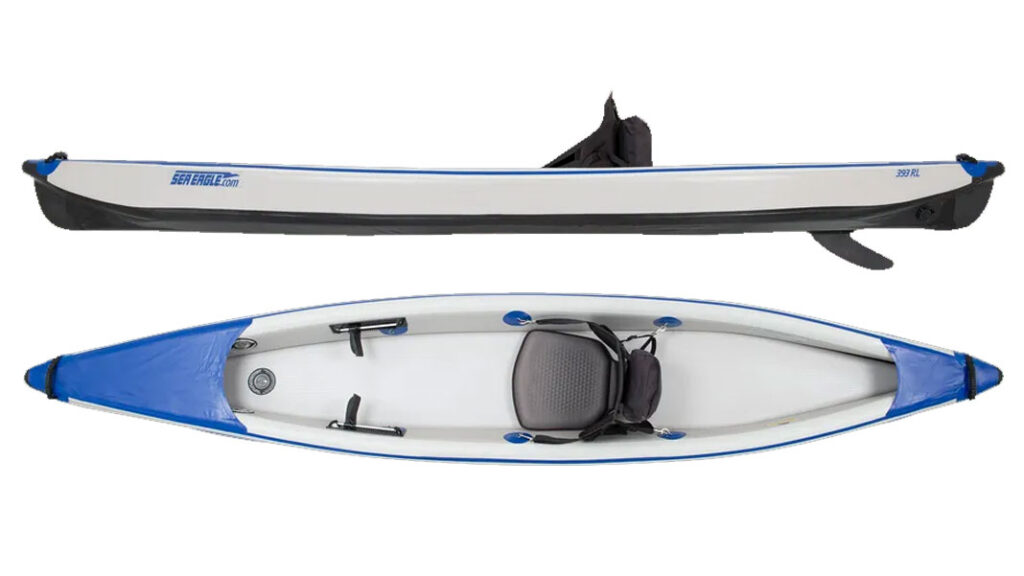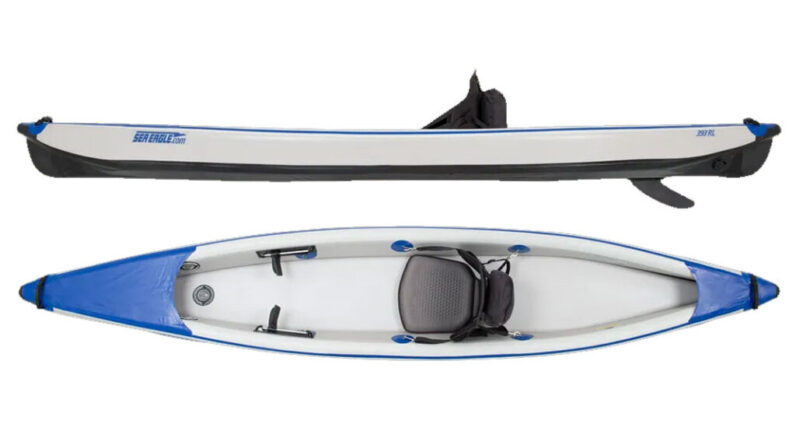
Have you ever wondered what the difference is between inflatable kayaks and hard shell kayaks? Well, get ready to dive deep into the world of kayaking because today we’re going to compare the two! So, whether you’re a seasoned kayaking enthusiast or a beginner looking to get started, this article will provide you with all the information you need to make an informed decision.
Let’s start with inflatable kayaks. These kayaks are incredibly versatile and easy to store. They can be deflated and folded up into a backpack, making them perfect for those who have limited storage space or plan to travel with their kayak. Inflatable kayaks are also usually more affordable than their hard shell counterparts, which is great news for those on a budget. However, you might be wondering if they are as durable as hard shell kayaks. Well, you’d be surprised to learn that many inflatable kayaks are made with high-quality materials that can withstand rough waters and even sharp objects like rocks.
Now, let’s talk about hard shell kayaks. These kayaks are usually made of durable materials such as fiberglass, plastic, or even wood, which makes them incredibly sturdy and long-lasting. If you’re planning to use your kayak in rough waters or for activities like fishing or white-water rafting, a hard shell kayak might be the better choice for you. Additionally, hard shell kayaks tend to offer better stability and maneuverability, especially in windy conditions. However, it’s worth noting that hard shell kayaks can be heavier and more difficult to transport, so keep that in mind if you’re someone who values portability.
In this article, we’ll dive deeper into the pros and cons of both inflatable and hard shell kayaks, as well as discuss their different uses and features. By the end of it, you’ll have a better understanding of which type of kayak will best suit your needs and preferences. So, if you’re ready to embark on your kayaking journey, let’s get started!
Kayaks Inflatable Vs Hard Shell
Introduction
When it comes to choosing a kayak, two primary options are often considered: inflatable kayaks and hard shell kayaks. Both types have their own unique characteristics, benefits, drawbacks, and performance capabilities. In this article, we will explore the definition and characteristics of both inflatable and hard shell kayaks, their performance and versatility, transportation and storage options, durability and maintenance considerations, cost and value, comfort and accessibility features, and the environmental impact of each type. By the end, you will have a better understanding of which type of kayak suits your needs and preferences.
Definition and Characteristics of Inflatable Kayaks
Materials Used in Inflatable Kayaks
Inflatable kayaks are made from durable materials, typically PVC or Hypalon. These materials are lightweight yet sturdy, making them suitable for a variety of water conditions. PVC inflatable kayaks are often more affordable, while Hypalon options are known for their superior resistance to UV rays, oil, and chemicals. Both materials offer flexibility, making them easy to pack and transport.
Benefits of Inflatable Kayaks
One of the main advantages of inflatable kayaks is their portability. They can be deflated and packed down into a compact size, ideal for transportation and storage. This makes them a great choice for those with limited space or for those who like to travel with their kayak. Inflatable kayaks are also relatively lightweight, making them easier to carry and maneuver.
Another benefit of inflatable kayaks is their stability. Due to their wider hull and inflatable chambers, they offer excellent stability on the water, making them suitable for beginners or those who prefer a more stable ride. Inflatable kayaks also have a higher weight capacity compared to hard shell kayaks, allowing for additional gear or passengers.
Drawbacks of Inflatable Kayaks
While inflatable kayaks have many advantages, they also come with a few drawbacks. One concern is their vulnerability to punctures or tears. Although they are made from durable materials, sharp objects or rough conditions can potentially damage the kayak. However, punctures and tears can often be repaired using patch kits provided by the manufacturer.
Inflatable kayaks also tend to have a slower speed compared to hard shell kayaks. This is due to their design, as the inflatable chambers create more drag in the water. If speed is a priority for you, a hard shell kayak may be a better option.

Definition and Characteristics of Hard Shell Kayaks
Materials Used in Hard Shell Kayaks
Hard shell kayaks are typically made from plastic, fiberglass, or composite materials. Plastic kayaks, commonly made from polyethylene, are known for their durability and affordability. Fiberglass kayaks are lightweight and offer excellent performance on the water. Composite kayaks, made from a combination of materials such as carbon fiber or Kevlar, are even lighter and provide exceptional speed and maneuverability.
Benefits of Hard Shell Kayaks
Hard shell kayaks are known for their performance and maneuverability. They offer a sleek design, allowing for faster speeds and easier maneuvering through the water. If you enjoy kayaking for fitness or participating in races, a hard shell kayak may be the better choice due to its speed capabilities.
Another benefit of hard shell kayaks is their durability. Plastic kayaks, in particular, are resistant to punctures and can withstand rough conditions. They require minimal maintenance, making them a convenient option for those who want a kayak that can withstand wear and tear.
Drawbacks of Hard Shell Kayaks
One of the main drawbacks of hard shell kayaks is their weight and bulkiness. They can be challenging to transport, especially if you don’t have a suitable roof rack or trailer. Storage space can also be an issue, as they require a dedicated area to keep them protected when not in use.
Hard shell kayaks also tend to be more expensive compared to inflatable kayaks. The materials used and the manufacturing process contribute to their higher price point. If budget is a concern, inflatable kayaks may be a more affordable choice.
Performance and Versatility
Stability and Manoeuvrability of Inflatable Kayaks
Inflatable kayaks are known for their stability on the water. The wider hull and the inflatable chambers provide a stable platform, allowing beginners to feel secure and confident. However, due to their design, inflatable kayaks are generally slower and less maneuverable compared to hard shell kayaks. They may not be as responsive to quick turns or changes in direction.
Stability and Manoeuvrability of Hard Shell Kayaks
Hard shell kayaks excel in performance and maneuverability. With their sleek design and lightweight materials, they provide faster speeds and better maneuverability on the water. Hard shell kayaks are highly responsive to paddle strokes, making them ideal for advanced paddlers or those seeking a more dynamic kayaking experience. However, they may require more skill and balance, especially for beginners.
Suitability for Different Water Conditions
Both inflatable and hard shell kayaks can be used in a variety of water conditions, including lakes, rivers, and even open seas. However, it is important to note that hard shell kayaks tend to perform better in rougher conditions, thanks to their superior tracking and agility. Inflatable kayaks, on the other hand, may not handle strong winds or choppy waters as efficiently due to their wider hull and lightweight construction.
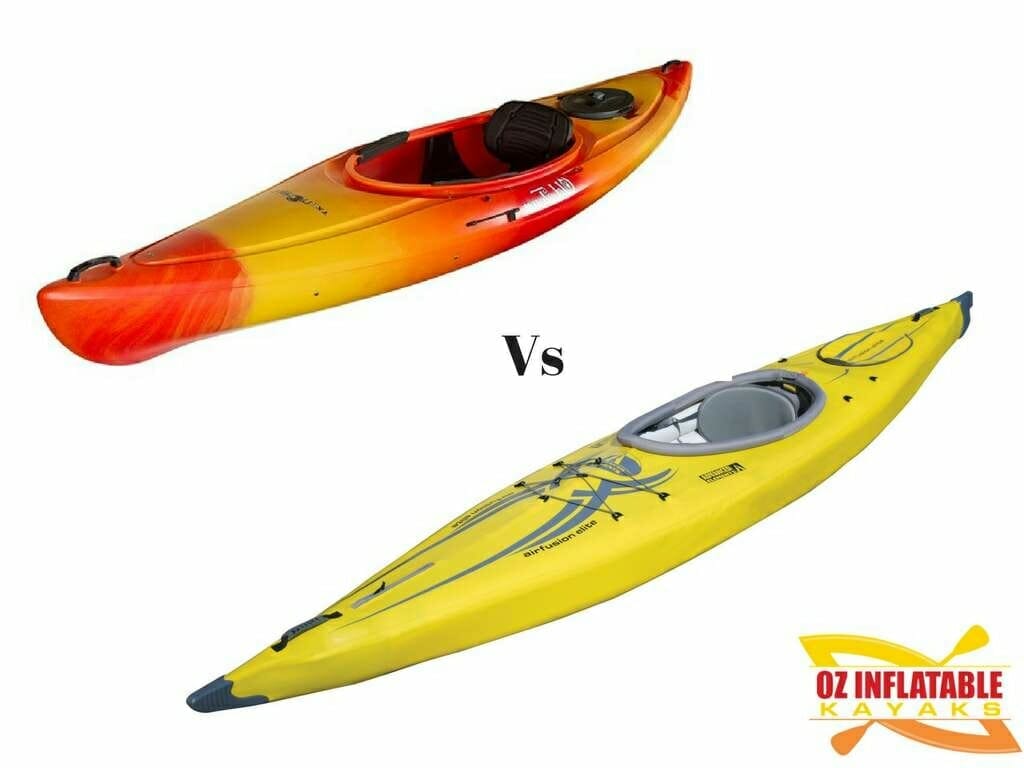
Transportation and Storage
Portability and Packability of Inflatable Kayaks
One of the main advantages of inflatable kayaks is their portability. They can be deflated and packed into a compact bag, making them easy to transport. Inflatable kayaks are lightweight and can be carried on your back or loaded into a car trunk. They can even be taken on flights, allowing you to explore new kayaking destinations while traveling.
Ease of Transporting Inflatable Kayaks
Transporting inflatable kayaks is relatively hassle-free. They can be easily loaded onto a roof rack or placed in the trunk of a car. Many inflatable kayaks also come with carry handles or backpack straps, making it convenient to transport them to and from the water. This flexibility in transport options makes them a great choice for those who frequently kayak in different locations.
Storage Space Required for Inflatable Kayaks
One of the major advantages of inflatable kayaks is their minimal storage space requirement. When deflated, they can be easily stored in a closet, under a bed, or even in a small apartment. This is beneficial for those who have limited storage space or prefer to keep their kayak out of sight when not in use.
Portability and Storage of Hard Shell Kayaks
Hard shell kayaks can be more challenging to transport due to their weight and size. They typically require a roof rack or a trailer for transportation. If you have limited space or live in an apartment, storing a hard shell kayak may also be a concern. You will need to allocate a dedicated storage area, such as a garage or shed, to keep your kayak protected from the elements and potential damage.
Durability and Maintenance
Durability and Resistances of Inflatable Kayaks
Inflatable kayaks are designed to be durable and resistant to punctures. While they are susceptible to damage from sharp objects or rough conditions, many manufacturers use high-quality materials and reinforce vulnerable areas to minimize the risk. Inflatable kayaks made from Hypalon also offer better resistance to UV rays, oil, and chemicals, increasing their lifespan. Additionally, most inflatable kayaks come with repair kits, allowing you to fix minor punctures or tears yourself.
Maintenance Requirements for Inflatable Kayaks
Maintaining an inflatable kayak is relatively straightforward. After each use, it is important to rinse off any saltwater or dirt to prevent build-up and damage. It is also recommended to let your kayak fully dry before deflating and storing it to avoid mildew or mold growth. Checking for any signs of wear or damage periodically is crucial for ensuring the longevity of your inflatable kayak.
Durability and Resistances of Hard Shell Kayaks
Hard shell kayaks, especially those made from plastic, are highly durable and resistant to punctures. They are designed to withstand rough conditions, making them suitable for more adventurous kayaking endeavors. Fiberglass and composite kayaks are also known for their durability, but they may require more care and maintenance to prevent scratches or cracks.
Maintenance Requirements for Hard Shell Kayaks
Maintaining a hard shell kayak typically involves regular cleaning and inspection. It is recommended to rinse off any saltwater or dirt after each use and to store it in a protected area, away from direct sunlight or extreme temperatures. Checking for any signs of damage, such as cracks or leaks, is important for ensuring your kayak’s long-term durability. Minor scratches can be repaired using kayak repair kits specific to the material of your kayak.
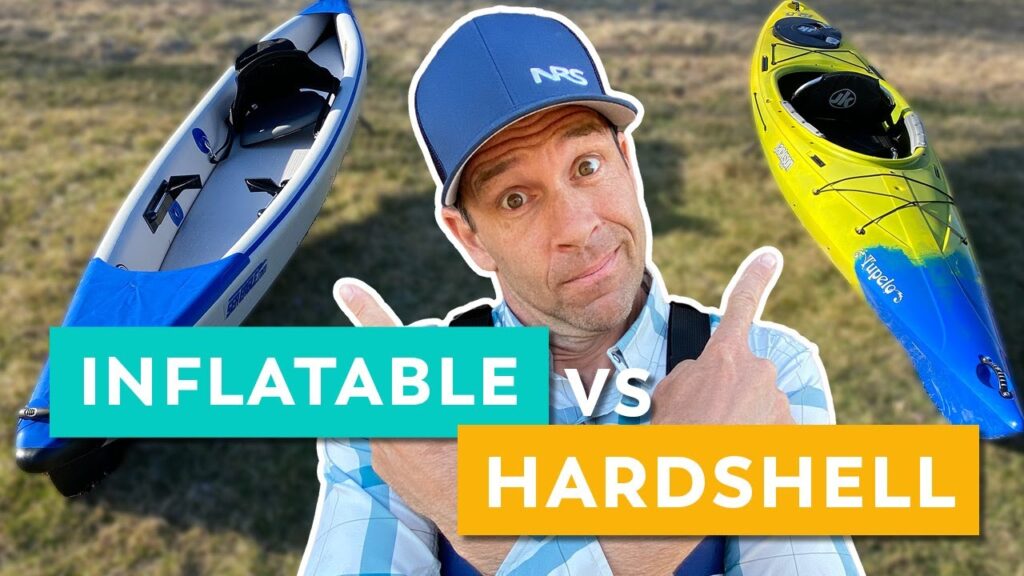
Cost and Value
Price Range of Inflatable Kayaks
Inflatable kayaks generally have a lower price range compared to hard shell kayaks. The price can vary depending on the brand, size, and features of the kayak. Entry-level inflatable kayaks can start as low as $100, while more advanced models with additional accessories can range up to $1000 or more.
Factors Contributing to the Cost of Inflatable Kayaks
The cost of inflatable kayaks can be influenced by several factors. Higher-priced models often come with additional features such as adjustable seats, reinforced chambers, or better materials. Branded kayaks may also have a higher price tag due to their reputation for quality and durability. Additional accessories such as paddles, life vests, and pumps may also contribute to the overall cost.
Price Range of Hard Shell Kayaks
Hard shell kayaks generally have a higher price range compared to inflatable kayaks. The price varies depending on the material, size, and brand of the kayak. Entry-level plastic kayaks can range from $200 to $1000, while fiberglass or composite kayaks can start from $1000 and go upwards of $5000 or more for high-end models.
Factors Contributing to the Cost of Hard Shell Kayaks
The higher cost of hard shell kayaks can be attributed to the quality and durability of the materials used, the manufacturing process, and the reputation of the brand. Composite kayaks, which are often regarded as the top tier in terms of performance, tend to be more expensive due to their lightweight construction and superior speed capabilities. Higher-priced models may also come with additional features or accessories, such as rudders or advanced seating systems.
Long-Term Value Considerations
When considering the cost and value of a kayak, it is important to think about your long-term usage and preferences. While inflatable kayaks may be more affordable initially, they may require more frequent repair or replacement due to their vulnerability to punctures. On the other hand, hard shell kayaks, although more expensive, tend to be more durable and require less maintenance. If you plan on kayaking regularly and have the budget, a hard shell kayak may provide better long-term value.
Comfort and Accessibility
Comfort Features of Inflatable Kayaks
Inflatable kayaks often come with comfortable seating options, including adjustable backrests and inflatable seats for added cushioning. Some models also have footrests and thigh straps for better support and comfort during long paddling trips. The wider hull and stability of inflatable kayaks contribute to a comfortable and relaxing ride, making them suitable for novice kayakers or those who prefer a more leisurely kayaking experience.
Comfort Features of Hard Shell Kayaks
Hard shell kayaks also offer a range of comfort features. Many models come with padded seats and adjustable backrests to provide optimal support during long hours of paddling. Some kayaks even have ergonomic designs that contour to the body for enhanced comfort. Hard shell kayaks are known for their superior performance, which can contribute to a more exhilarating and enjoyable kayaking experience for those seeking faster-paced adventures.
Accessibility and Ease of Use for Different Ages and Physical Abilities
Both inflatable and hard shell kayaks can accommodate different ages and physical abilities. Inflatable kayaks, with their stability and ease of use, are suitable for beginners, children, and those with limited upper body strength. The wider hull and steady platform make it easier to get in and out of the kayak, making it accessible for individuals with mobility issues.
Hard shell kayaks, although requiring a bit more skill and balance, can also be adapted for different age groups and physical abilities. Some models offer paddle-assist systems or adjustable seating positions to accommodate different heights or reach. It is important to consider your individual needs and physical abilities when choosing a kayak to ensure a comfortable and enjoyable experience on the water.
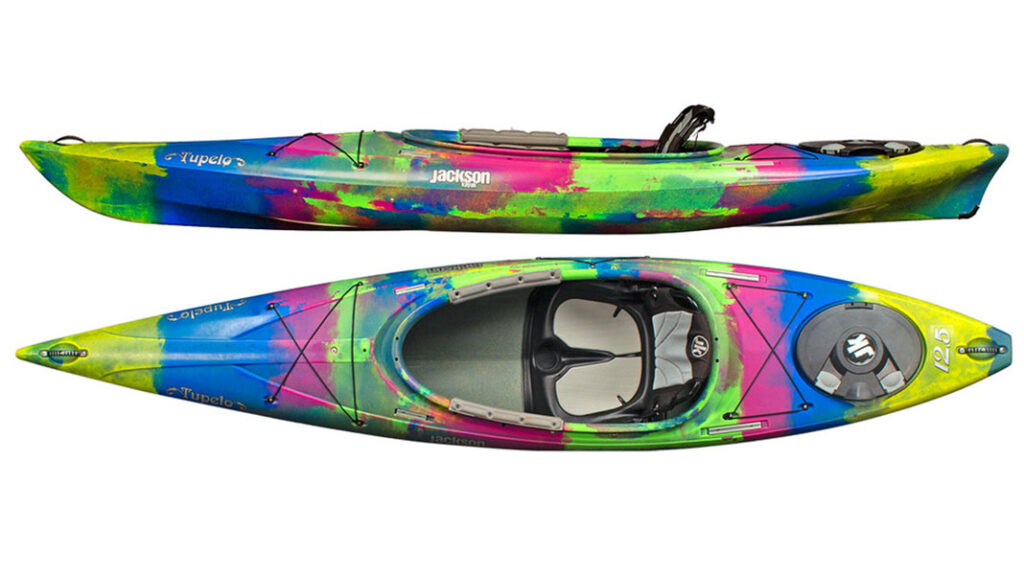
Environmental Impact
Environmental Benefits of Inflatable Kayaks
Inflatable kayaks offer several environmental benefits. The PVC or Hypalon materials used in their construction are recyclable, reducing their long-term impact on landfills. Inflatable kayaks also have a lower carbon footprint compared to hard shell kayaks during the manufacturing process, as they require less energy and produce fewer greenhouse gas emissions. Additionally, the lightweight and portable nature of inflatable kayaks make them more accessible for eco-conscious individuals who want to explore nature without leaving a large carbon footprint.
Environmental Impact of Hard Shell Kayaks
Hard shell kayaks, especially those made from plastic, can have a significant environmental impact. Plastic kayaks are not easily recyclable and can contribute to plastic pollution if not properly disposed of at the end of their lifespan. However, it is worth noting that some manufacturers are now using recycled plastic materials to reduce their environmental footprint. Fiberglass and composite kayaks also require energy-intensive manufacturing processes, contributing to their overall ecological impact.
Sustainability Factors
When considering the environmental impact of kayaks, it is important to consider sustainability factors beyond the materials used. Both inflatable and hard shell kayaks can contribute positively to the environment if used responsibly. This includes practicing Leave No Trace principles while kayaking, properly disposing of any waste, and respecting wildlife and natural habitats. Choosing a kayak made by a brand with strong sustainability initiatives can also contribute to minimizing the ecological footprint of your kayaking adventures.
Conclusion
Inflatable and hard shell kayaks each have their own unique characteristics, benefits, and drawbacks. Inflatable kayaks offer portability, stability, and affordability, making them a great choice for beginners or those with limited storage space. On the other hand, hard shell kayaks provide superior performance, durability, and speed, which can be appealing to more experienced paddlers or those seeking a more dynamic kayaking experience. Consider your individual needs, preferences, and budget when making a decision, and remember to prioritize safety, comfort, and the environment in your kayaking adventures. Whether you choose an inflatable or hard shell kayak, the joy and serenity of exploring the waterways await you. Happy kayaking!
